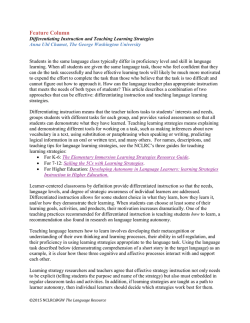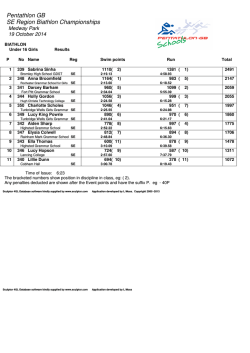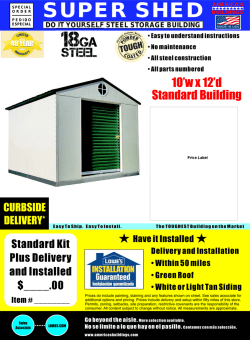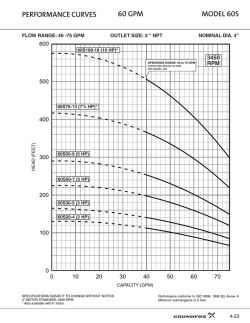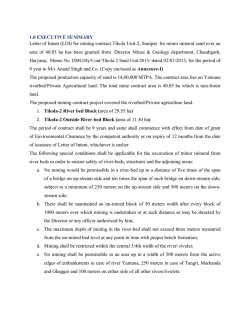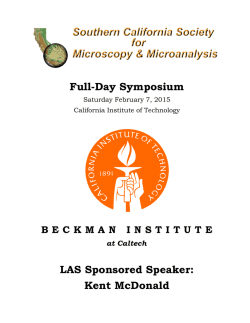
Lucy Cranitch - 2015 Composites Conference
PATH Composites in Mining and Minerals Processing Lucy Cranitch PATH Lucy Cranitch PATH Outline 1 A 1. Application li ti and d Opportunities for Composites in Mining • Vessels • Pipelines • Infrastructure 2. Materials • What Are Composites • Properties • Cost Comparison • Failure Modes Questions Lucy Cranitch 3 Working With Composites 3. • Design • Manufacture • Transport • Installation • Use • Inspection & Testing Questions PATH Composites • • • • • Fibreglass FRP = Fibre b e Reinforced e o ced Plastic as c GRP = Glass Reinforced Plastic GRE = Glass Reinforced Epoxy CFRP = Carbon Fibre Reinforced Plastic Lucy Cranitch PATH Application and Opportunities for Composites in Mining Minerals Processing Vessels Lucy Cranitch PATH Mineral Processing Vessels Zinifex. Sulphuric Acid Plant. Tank Stack Mercury M Launders Removal Tower Gas Cooling Tower 10% S l h i acid/ Sulphuric id/ zinc sulphate Clarifier Cover Cover. Water Reactor Tanks Gas Flue valves Electrolytic Cells Vapour + acid 70oC Copper Sulphate To 180oC Lucy Cranitch PATH Pipelines • Western Corridor Recycled Water Pipeline • Underground g p pipeline p to take treated water industry. • Output: up to 282 ML/day. • Pipe: Flowtite • Length: 80 km • Diameter: 1000 and 1200 mm • Pressure: 1.6 and 2.5 MPa • Standard: AS 3571 • Other composite parts: Bends and Tee Pieces Lucy Cranitch PATH Pipelines in Iron Ore • Transport iron ore as a slurry from mine to coast • Return water to mine • Length: 290 km • Diameter: 600 mm • Pressure: up to 5 MPa • Standard: ISO14692 and AS 2885 • Drivers: salt & oxygen in water, GRP cheaper than steel • Challenge: Abrasive solids Lucy Cranitch PATH Pipelines in Bore-fields • Bore-fields between iron ore mine and coast • Top up pipeline with water • W t may be Water b ponded d db between t mine i and d coastt • Diameter: 450 mm • Pressure: up p to 5 MPa • Drivers: salty water, composite can be cheaper than HDPE Lucy Cranitch PATH Mining Infrastructure Mine Vent Ducting Rock Bolts Lucy Cranitch PATH Mining Infrastructure Truck bodies & panels Wash plant pipes Ladders, handrails, steps, platforms Drill Rods St Storage containers t i – water, t fuel f l Lucy Cranitch PATH Mining Infrastructure Grating Cable Supports Lucy Cranitch Handrails Stairs Rebar Roof and Wall Sheeting PATH Lucy Cranitch Courtesy of GCDA PATH Outline 1 A 1. Application li ti and d Opportunities for Composites in Mining • Vessels • Pipelines • Infrastructure 2. Materials • What Are Composites • Properties • Cost Comparison • Failure Modes Questions Lucy Cranitch 3 Working With Composites 3. • Design • Manufacture • Transport • Installation • Use • Inspection & Testing Questions PATH Materials Reinforcement 1. support load Resin 1. bond fibres together 2 distribute forces 2. 3. barrier to water, chemicals, UV, abrasion Lucy Cranitch Carbon Highest specific stiffness Kevlar Highest specific strength. Impact pact resistance es sta ce Glass High strength, low price Epoxy Adhesion, mechanical properties Vinyl Ester Chemical resistance, toughness Polyester Inexpensive Price Price PATH Materials – Reinforcement Forms Type Form Function E Glass Continuous Fibres Unidirectional Fabric Strength in 1 direction Fabrics e.g. woven roving, cloth, stitched fabric Strength in 1,2 or 3 directions Fibres Chopped Strand Mat Strength in all directions Inter-laminar adhesion Tissue/Veil Supports resin rich layer – provides moisture & chemical barrier C glass, synthetic or carbon Lucy Cranitch PATH 1 2 3 Lucy Cranitch PATH Materials Resins M t l Metals • • • • Carbon Steel Stainless Steel • 304 • 316 • 317 Titanium Al i i Aluminium Lucy Cranitch • • • Epoxy - mechanical Vinyl Esters – chemical properties • Bisphenol Vinyl Ester – standard • Novolac Vinyl Ester – high performance Polyesters • Orthophthalic – low cost • Isophthalic - water • Terephthalic - fuel • Chlorendic - chemical • Bisphenol A Fumarate - chemical PATH Manufacture Hand Lay Up Lucy Cranitch Filament Winding Pultrusion PATH Outline 1 A 1. Application li ti and d Opportunities for Composites in Mining • Vessels • Pipelines • Infrastructure 2. Materials • What Are Composites • Properties • Cost Comparison • Failure Modes Questions Lucy Cranitch 3 Working With Composites 3. • Design • Manufacture • Transport • Installation • Use • Inspection & Testing Questions PATH Mining Industry Drivers COST • Extend life of assets – leads to less capital cost • Reduce maintenance - can be as high as 50% of operating costs • Increased cost of steel and fuel SAFETY - Fire, Corrosion, Lift loads, Electrocution • Less hazardous materials and designs TIME • Quicker installation & start up • Long L d delivery li titimes ffor other th materials t i l whilst hil t need d tto iincrease production now. • Increase plant running time • Reduced failure & thus downtime Lucy Cranitch PATH Why Change Materials? • • • • Don t change unless impetus. Don’t Mining Industry is conservative as failure is extremely expensive – shutdowns cost at least $1 million per day. q p is balanced against g benefits Cost of equipment Need solutions to existing problems Mining Industry Drivers Composite Strengths Reduce Costs Corrosion Resistance Increase Safetyy Non Conductive or Conductive Increase Uptime Light Weight Lucy Cranitch PATH Properties of Composites Materials – Chemical Properties Polyester Resin Vinyl Ester Resin Acids (weak) Acids (strong) x Bases x Solvents S lt Solutions Salt S l ti pH 0-14 Can also be used for potable water if resin is certified for AS4020 Lucy Cranitch PATH Materials – Chemical Properties • • • • • Tanks T k & Process P Vessels V l Pipelines Grating & Handrails C Conveyors Trucks & Mobile Equipment Mining Industry Drivers Cost Reduction * Extend life of assets * Reduce maintenance – no painting Safety y * No corroded gratings or handrails Increase Plant Running Time * Reduced failure & thus downtime Lucy Cranitch PATH Corrosion Resistance can Increase Safety Lucy Cranitch PATH Materials – Chemical Properties Incitec Pivot - Mt Isa Sulfuric Acid Plant continuously operating since 1999 • Sulfur dioxide and sulfur trioxide gas • Sulfuric acid. • 68oC Settlers Piping Radial Flow Scrubber Gas Cooling Tower Ducts Inlet Manifold Lucy Cranitch PATH Materials – Chemical Properties Jamison Cells BHP Billiton – Olympic Dam • Uranium solvent extraction plant • Precipitation and calcination plant • Copper solvent extraction plant Chemicals • ammonium sulphate • sulfuric acid • sodium carbonate • hydrogen peroxide Lucy Cranitch Mixer Settlers & Internals Tank PATH Materials - Mechanical Properties Material Glass Composite Mild Steel Stee Aluminium Density (g/cm3) 1.5-2.5 7.8 2.7 Tensile T il Strength St th (MPa ) 50 700 50-700 410 480 410-480 80 480 80-480 Tensile Modulus (GPa ) 10-60 190-210 70 Tensile Elongation (%) 1.6-2.1 22-37 2.5-23 Lucy Cranitch PATH Materials - Light Weight Composites weigh 6 x less than steel for the same strength • • • • • Electrical guarding (lift loads) Hatches (lift loads) Tanks & process vessels (at Installation) Conveyors (fuel saving) T k & Mobile Trucks M bil E Equipment i t (fuel saving) Lucy Cranitch Mining Industry Drivers Cost Reduction * Reduced installation costs * Reduced fuel cost Safety - Lift loads * Less hazardous materials & designs Increase Plant Running Time * Quicker installation & start up PATH Materials - Light Weight Lucy Cranitch PATH Materials - Abrasion Properties Can be improved by: • 3-5% hard fillers such as silicon carbide helps. Either in a coating or part of the corrosion barrier • Flooring or trowel on pastes can have up to 40% silicon carbide or other abrasion resistant fillers. • Use of a veil, particularly a carbon veil increases abrasion resistance. Lucy Cranitch PATH Materials – Thermal Properties • Max temp of composites is determined by HDT of resin. • AS2634 - HDT of the resin shall be not less than 20°C above the design temperature. • Some composites can be used up to 250°C Isophthalic p Polyester y Resin (ESTAREZ® 3-491P) Standard Vinyl y Ester Resin (HETRON® 922) High g Performance Vinyl Ester Resin (HETRON® 970/35) HDT at 1.82 MPa (°C) 85 100 149 Elongation to Break (%) 2.5 6.5 3.5 Lucy Cranitch PATH Materials – Thermal Properties Temp (C) Tensile Strength of Resin (MPa) -43 117 25 109 65 147 95 147 120 121 150 74 Coeff-thermal expansion deg C x 10-6 Lucy Cranitch Mild Steel Composite 12 5-35 PATH Materials – Thermal Properties Delta Electrolytic Manganese Dioxide plant • Electrolytic Tanks and 60 El t l ti C Electrolytic Cells ll • 4% sulphuric acid at 97-100°C • Some tanks cycle between 97°C and ambient every 6 hours • Larger tanks are typically between 60°C and 70°C • HETRON® 980 Resin • After 10 y years of continuous operation, the resin was still performing well, although some mechanical issues had to be addressed Lucy Cranitch PATH Materials – Non Conductive Composites are natural insulators Rio Tinto , Aluminium Smelter • Claustra Walls in Pot Room • Telescopic tools. tools • Electrowinning Materials Requirements • electrically insulating. • fire retardant. • corrosion resistant resistant. • lightweight. • pigmented. • high physical strength. Lucy Cranitch Mining Industry Drivers * Safety – no electrical sparking, no electrocution PATH Materials – Conductive Composites can be made conductive • • • Static charge can build-up in stacks,, tanks,, piping p p g and ducts EMP’s and solvent extraction require conductive laminates Grounding composite equipment is critical. Mining Industry Drivers Cost Reduction * Reduced failure = reduced rebuild cost Safety * Reduced incidence of fire Lucy Cranitch Increase Plant Running Time * Reduced failure & thus downtime PATH Materials – Conductive • Construction • Carbon Surfacing Veil saturated with resin containing 5 -15 % w/w carbon/graphite filler. • Ensure continuity across joints where applicable • Grounding g must be p provided through g to the outside of the equipment. Titanium or stainless steel bolts and a putty made from the carbon/graphite filler • Test – Megger gg BM80 or BM 2580 Lucy Cranitch PATH Materials – Fire Properties • • • • • Composites will burn but fire retardant composites available including Hetron FR992, Hetron 197 or Derakane 510A and 510C Ducts for flammable gases may require fire retardant resin for internal layer. y Tanks may require fire retardant resin for external layer. Tested to AS1530 pt3, cone calorimeter or ASTM E-84 flame spread of ≤25 (Class 1) Fire retardants can reduce chemical resistance Resin HETRON ® 197 Lucy Cranitch Tendency y to Ignite 12 Heat Developed 0 Flame Spread 1 Smoke 7 PATH Materials – UV Properties • • • • UV can chalk outside layer of composites or degrade composites over time A pigmented layer will protect composites Since pigmented layer limits inspection, it should be applied after all QA complete Alternatively UV inhibitors can be used in the resin Lucy Cranitch PATH Material Properties - Drivers for Composite Use Corrosion resistance Long life with low maintenance reduce cost Safety Non Conductive or C d ti as required Conductive i d Safety High strength and light weight Installation – quicker – save time, less hazardous, reduce cost Safety Large unsupported covers possible Lucy Cranitch PATH Cost Comparison • • • • • Australian A li C Company Tank: 3 m diameter, 5 m high 70% Sulphuric Acid Wall thickness 6 mm in steel and 15 mm in composites Specific Gravity of steel 7.8 cf 1.6 for composites – tank half the weight g in composite p Tank Material Tank Fabrication Cost Cost Ratio SAF 2205 Stainless Steel $130,467 1.3 316 Stainless Steel $110,897 1.1 Mild Steel $58,710 0.6 Composite $99,720 1.0 Lucy Cranitch PATH Cost Comparison • • • • Pipe Diameter 150 mm P Pressure 700 kPa kP 12 m length, 1 flange, 1 elbow 90 degrees, 2 joints/welds, 2 mild steel supports Pipe Material Fabrication Installation Supply & Installation SAF 2205 Stainless Steel 6.3 1.1 3.6 316 Stainless Steel 1.6 1.1 1.4 Composite 1.0 1.0 1.0 Lucy Cranitch PATH QUESTIONS? Lucy Cranitch PATH Outline 1 A 1. Application li ti and d Opportunities for Composites in Mining • Vessels • Pipelines • Infrastructure 2. Materials • What Are Composites • Properties • Cost Comparison • Failure Modes Questions Lucy Cranitch 3 Working With Composites 3. • Design • Manufacture • Transport • Installation • Use • Inspection & Testing Questions PATH Failure Modes • • • • • Poor QA during production Chemical degradation E i iin pipes Erosion i Cracking and Delamination Impact Lucy Cranitch PATH Failure Modes - QA Poor QA During Production • Balance between Quality and Price • Resins which are not as corrosion resistant • Fibre layout not consistent • Laminate too thin (hydro testing fail) • Not cured properly (wrong/insufficient ( /i ffi i t catalyst, t l t initiator, i iti t promoter t and/or d/ temperature. Postcure) • • Insufficient overlaps in laminate and at joints Insufficient inspection and testing Lucy Cranitch PATH Failure Modes – Blisters & Softening • Fluids entering the laminate creates pressure. • Pressure causes the laminate to detach & blister. Laminate Fluid Correct resin and tissues help minimise this. “The resin rich layer shall be of a minimum thickness of 0.25 mm and shall contain ‘C’ Glass surfacing tissue or synthetic fibres such as polyester or acrylic fibres of minimum dry thickness 0 0.25 25 mm mm. Minimum resin content by weight shall be nominally 90%.” [AS2634] Lucy Cranitch PATH Failure Modes - Chemical Degradation • • Splash of 95% sulphuric Acid Wrong material in this environment Or • Process conditions outside of specification Lucy Cranitch PATH Failure Modes – Erosion of Pipes Can be improved by: • 3-5% hard fillers such as silicon carbide helps. Either in a coating or part of the corrosion barrier • Use of a veil, particularly a carbon veil increases abrasion resistance. Lucy Cranitch PATH Failure Modes – Delamination & Cracks • • • At flange faces At corners At secondary joins • Procedure for flange tightening Avoid sharp corners Don’tt over pressurise Don pipes • • Lucy Cranitch PATH Failure Modes - Impact • Effects structural integrity but can also crack the internal resin • During transport • use correctt supports, t cradles, dl padding ddi and d stiffening tiff i d devices i • During installation • use lifting lugs, webbing or soft slings • avoid shock loads and sliding • ensure supports are correct • During use • avoid hydroblasting • take care with forklifts etc. Lucy Cranitch PATH Outline 1 A 1. Application li ti and d Opportunities for Composites in Mining • Vessels • Pipelines • Infrastructure 2. Materials • What Are Composites • Properties • Cost Comparison • Failure Modes Questions Lucy Cranitch 3 Working With Composites 3. • Design • Manufacture • Transport • Installation • Use • Inspection & Testing Questions PATH Design Life • • • It depends on the conditions of use Design life of a minimum 20 years continuous operation is typical in the mining g industry y Design life up to 100 years now specified for water and waste industry Examples: p • Bleach washer hoods were used for 17 years in a Canadian pulp and paper mill. • High performance polyester have operated in chemical service for 25 years and still been in sound condition condition. • Underground fuel storage tanks. Isophthalic resin. Exhumed after 25 years service and shown little or no physical or chemical degradation. Lucy Cranitch PATH Design Life Example Uptime i Lucy Cranitch PATH Design – Resin Selection Resin Selection Guides Lucy Cranitch PATH Design - Standards Pipes and Pi d Ducts D t • AS 2634. Australian Standard for “Chemical Plant Equipment made from Glass-Fibre Reinforced Plastics (GRP) based on Thermosetting Resins” • AS 2566 Buried Flexible Pipelines • BS 7159 Code of Practice for Design and Construction of Glass Reinforced Plastics (GRP) piping systems for individual plant sites. • BS 6464 Reinforced Plastic Pipes, Fittings and Joints for Process Plants • ISO 14692 Petroleum and natural gas industries — Glass-reinforced plastics (GRP) piping. [Use for high pressure or SX pipes] Lucy Cranitch PATH Design Detail Pressure • • API 15 HR Specification for High Pressure Fiberglass Line Pipe – 2001 cover pipes rated for 3.45 3 45 MPa to 34 34.5 5 MPa MPa. 18 MPa pipe typically available for oil and gas. Supports • • • • For pipes and ducts, BS 6464 contains information on installation including supports, guides and anchors. Pipe p support pp spacing p g is important p to limit deflection,, for example p using g a maximum deflection to span ratio of 1:300. A minimum contact arc of 120° under the pipe is typical. Rubber packers can help Lucy Cranitch PATH Design - Standards Tanks T k and d Process P Vessels V l • AS2634. Chemical Plant Equipment Made From Glass-Fibre Reinforced Plastics (GRP) Based on Thermosetting Resins. • BS4994. Design and Construction of Vessels and Tanks in Reinforced Plastics • BS EN 13121 GRP Tanks and Vessels For Use Above Ground • BS EN 13923 Filament Wound FRP Pressure Vessels – Materials, design, manufacturing and testing Lucy Cranitch PATH Design Detail - Tanks and Process Vessels Support • Concrete slab or alternative Lucy Cranitch PATH Design - Joints Butt and strap • Strength must be at least equivalent to parent material • Laminate internal surface where accessible • Widths are g given in standards • Hand lay-up design thickness • Resin seal all cut ends Lucy Cranitch PATH Design - Joints Branch B h joints j i • Similar Requirements to b tt and butt d strap t joints • Need additional reinforcement i f t to t replace strength of cut out. Lucy Cranitch PATH Design - Joints Flanges • Composite flanges • Compatible with steel • ANSI Dimensions • Full flat faced suggested. Flatness important • Steel backing rings can be used • Washes under nuts • Care with bolt torque • Care with nozzle projections (not too far) • Resin seal all cut outs Lucy Cranitch PATH Tank Lining • Line concrete or steel tank with composites Dual Laminate Systems y – Line Fibre Composite p tank with plastic p • Polypropylene • PVC & CPVC • Fluorinated – PVDF, ECTFE, FEP • Test for suitability (corrosion & erosion) – in exact solution, under load • When acting as corrosion barrier - minimum bond strength of 7 MPa in direct shear & 5 N/mm width in peel. p • Materials usually come glass backed for laminate adhesion Lucy Cranitch PATH Concrete Floor and Bund Protection Concrete Primer - Resin + 10% Styrene Monomer. Three layers of 450 g/m2 powder bound chopped strand mat 1 mm y of One resin rich layer 20 g/m² surface tissue 3 mm 1 mm 0.5 mm Lucy Cranitch Top coat - Resin + 0.5% Wax in Styrene Sand non slip surface PATH Concrete Primer - Resin + 10% Styrene Monomer. Base coat - Resin + graded silica sand aggregate. 1 mm 5 - 15 mm Top coat - Resin + 0.5% Wax in Styrene 0 5 mm 0.5 Lucy Cranitch Concrete Floor and Bund Protection Sand non slip p surface PATH Concrete Floor and Bund Protection Olympic Dam - 12,000 m2 of concrete protection across site Particularly in solvent extraction area Chemical Environments 1 1. S l h i acid, Sulphuric id pH H0 0.8 8 2. Ammonia and ammonium sulphate 3. Ethanol 4. Kerosene 5. Caustic soda & sodium carbonate, pH 12-13 6 6. Chlorides 7. Fluorides 8. Sodium chlorate Lucy Cranitch PATH Working With Composites • • • • • • Design Manufacture T Transport t Installation Use Inspection and Testing Lucy Cranitch PATH Manufacture - Post-cure • • Must post-cure using heat, when used in aggressive corrosive applications P t Post-cure gives i a more complete l t cure (further (f th crosslinking). li ki ) This Thi gives higher mechanical properties, heat distortion temperature (HDT) & chemical resistance. • Barcol hardness of at least 90% of datasheet value. Lucy Cranitch PATH Transport During transport use correct support support, cradles cradles, padding and stiffening devices Lucy Cranitch PATH Installation Installation should use correct supports supports, lifting lugs lugs, webbing or soft slings, avoid shock loads, avoid sliding Lucy Cranitch PATH Use • Avoid hydroblasting or use lower pressure • Avoid impact from equipment and machinery • Ensure process control Lucy Cranitch PATH Inspection and Testing Non-Destructive Methods • Visual Inspection • Barcol Hardness Testing • Cure C T Testing ti with ith A Acetone t • Tap Testing • Ultrasonic Testing • Acoustic Emission Destructive Methods • AS 3572 Plastics – Glass filament reinforced plastics (GRP) – Methods of test test. • Mechanical tests – tension, compression, shear, fatigue, creep, impact, modulus, stress & strain to break • Microscopy– Optical, Scanning Electron Microscopy • Accelerated A l t d ageing i – in i chemicals, h i l ffatigue, ti stress, t h heat, t UV Lucy Cranitch PATH Outline 1 A 1. Application li ti and d Opportunities for Composites in Mining • Vessels • Pipelines • Infrastructure 2. Materials • What Are Composites • Properties • Cost Comparison • Failure Modes Questions Lucy Cranitch 3 Working With Composites 3. • Design • Manufacture • Transport • Installation • Use • Inspection & Testing Questions PATH Summary Composites tend to replace more traditional materials including steel and concrete: • In corrosive environments • Where electrical insulation is required • Where light weight is required • Where low life cycle cost is desired With correct resin selection, materials design and manufacture, composite assets can give lifetimes of 20 to over 100 years depending on the application. Lucy Cranitch PATH Questions? Dr Lucy Cranitch Materials Scientist PATH Practical And Timely Help Consulting in composites, plastics, rubber & coatings M: 0420 664 631 E: [email protected] Lucy Cranitch
© Copyright 2025
